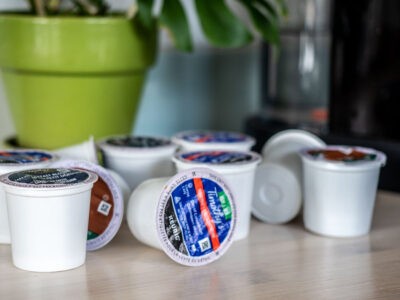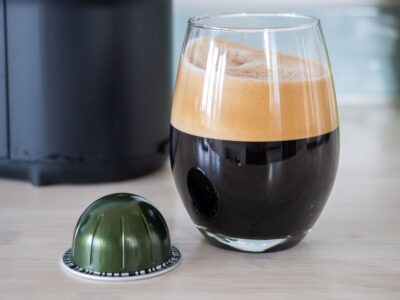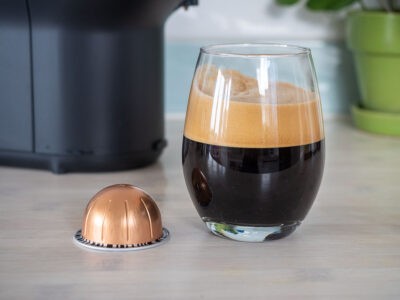Nespresso Guides, Nespresso Machines
How To Descale Nespresso With Vinegar (We Tested)
Vinegar is a versatile cleaner. It’s mild and effectively removes the most stubborn of stains. It’s incredibly budget-friendly too. While scouring the net, you may have encountered the rave of how this pantry staple can cut through calcium buildup in a Nespresso machine. The trick, however, is using ideal proportions. Because it’s acidic, you don’t want to use excessive amounts, as it can damage your machine, voiding your warranty. But, also, you don’t want to add too little and still have sediments and a strange odor and taste transferring into your coffee.
To descale your machine with vinegar:
- Empty the capsule container and drip tray.
- Fill the water tank with 500ml/17oz water and 500ml/17oz white vinegar.
- Turn on your machine and allow it to heat up.
- Place a container on the drip tray.
- Press and hold both buttons on your machine for 3 seconds, or select your brewer’s descaling mode.
- Allow the solution to run through the machine.
- Once descaling is complete, empty and rinse the water tank, mug, and drip tray. Place the mug back on the drip tray.
- Refill the water tank with plain water and run it through the machine to rinse out any leftover vinegar.
- Repeat the rinse cycle 3-5 times.
Carry on reading so you can properly descale your machine with vinegar.
Why Listen To Us? Well, because we KNOW coffee! In fact, we make our own coffee, coffee machine cleaners, and reusable capsules which we've sold to over 41 countries. Our team ouf experts include Tristan (an engineer), Claire (a food writer) and Richy (a barista). So, whether you're looking for a recipe or repair guide, we've got you covered 💚
Table of Contents
What You Can Use To Descale Your Nespresso Machine
Vinegar might be a readily (and cheaper) available agent, but it’s not the only one you can use to clean your machine. Here are other cleaning agents worth exploring.

Use commercial descaling products (Recommended)
Commercial descaling products are specifically formulated to descale coffee makers and are often faster and more effective than other methods. They are also less abrasive, so you don’t have to worry about corroding the internal components of your brewer.
Our go-to is this Eco Descaler from Amazon. It’s highly effective, fast acting, and odorless, which means we don’t have to worry about lingering odors transferring into our coffee or the likelihood of a malfunctioning machine.
Use white vinegar
Vinegar is acidic, making it effective at dissolving mineral buildup. It’s a readily available and affordable option too. The best thing about white vinegar is that it’s not as harsh as other vinegars–apple cider, red vinegar–so it won’t corrode the machine’s internal components. But also, it’s not as potent as commercial descaling products, so you will have to descale several times to remove all the calcium build-up.
Use citric acid
Citric acid is a natural ingredient (mainly derived from citrus fruit) that effectively breaks down mineral buildup, without the pungent odor. It’s commonly used in descaling products, but you can purchase it in powder form. But it can be more expensive than white vinegar and may be harder to find in stores.
Use baking soda (Not Recommended)
Baking soda is a weak base and not as effective as other descaling methods. It can also leave a residue that is difficult to remove. The residue can clog your machine, requiring you to send the machine for repairs or purchase a new brewer altogether.
Benefits of Using Vinegar for Descaling
- Budget-friendly: It’s readily available in most households and is an affordable alternative to specialized descaling products. It provides a cost-effective solution for maintaining your machine.
- Effective: Vinegar is acidic so it can effectively dissolve limescale and bacteria that can accumulate inside your brewer’s pipes.
- Non-toxic: Vinegar is generally safe to use and does not pose health risks. It’s a food-grade ingredient, making it a safer option compared to harsh chemicals that may leave residues or odors.
Disadvantages of Using Vinegar
- Odor: Vinegar has a strong odor that can linger in your machine if not rinsed thoroughly.
- Mild Acidity: It’s less potent than commercial descaling products, so it may take longer to remove heavy mineral buildup.
How To Descale Your Nespresso Machine With Vinegar (Step-By-Step)
Follow these simple instructions to get your machine sparkling clean.
Want instructions for your specific Nespresso machine? Checkout these articles below:
- How to descale your Nespresso Inissia coffee machine.
- How to descale your Nespresso Pixie coffee machine.
- How to descale your Nespresso U coffee machine
- How to descale your Lattissima Touch coffee machine
- How to descale your Nespresso CitiZ coffee machine

How much vinegar do you use to descale a Nespresso machine?
The best ratio to use for your Nespresso machine is 1:1. This translates to about 500 ml/17 oz of vinegar to 500 ml/17 oz of water.
You’ll need
- 500ml/ 17oz white vinegar
- 500ml/17oz water
- Large mug or container
Preparation
- Empty the capsule container and drip tray.
- Fill the water tank with vinegar and water.


General Method
- Turn on your brewer and allow it to heat up.
- Place the mug on the drip tray.
- Press and hold both buttons on your machine for 3 seconds, or select your brewer’s descaling mode.
- Once descaling is complete, empty and rinse the water tank, mug, and drip tray.
- Place the mug back on the drip tray.

Rinse cycle
- Fill the water tank with plain water.
- Run a rinse cycle 3-5 times.
Download: Get a copy of our descaling cheatsheet below.
Our Comparison Between Vinegar and Commercial Descaler
Commercial descalers are faster and more effective at removing limescale than vinegar, but they tend to be more expensive. Vinegar is safe, affordable, and readily available. Because it’s mildly acidic and has a pungent smell, we found we have to perform multiple descale and rinse cycles to ensure all the calcium buildup and odor are eliminated. If you have heavy mineral buildup or want a faster descaling process, it’s best to use a commercial descaling product.
Our 3 Tips for Descaling with Vinegar
- Descale Regularly
- Use the Correct Vinegar to Water Ratio
- Rinse Thoroughly Afterward
1. Descale regularly
Regular descaling with vinegar can help prolong the lifespan of your Keurig machine. It helps prevent clogs, improve water flow, and maintain optimal brewing conditions. This ensures you always enjoy a pleasant cup of coffee. As recommended by Keurig, it’s best to descale your machine every three to six months.
2. Use the correct vinegar-to-water ratio
Using too much vinegar can damage your machine, and using too little might not dissolve all the mineral buildup. We recommend you use a vinegar-to-water ratio of 1:1. This translates to about 16oz/473 ml vinegar and 16oz/473 ml water.
3. Rinse thoroughly afterwards
As mentioned, vinegar does have a strong odor, and if you don’t take the time to rinse thoroughly, the odor lingers and can transfer into your cup, affecting the quality of your coffee. After descaling, run several water-only brews to flush out all the residue.
Frequently Asked Questions
Q. How do I know my Nespresso machine needs descaling?
Here are a few signs your machine needs descaling:
A slow water trickle or your machine takes too long to fill a cup or doesn’t fill it all the way.
If you’re experiencing lingering tastes from previous brews that just won’t disappear no matter how many rinsing cycles you do.
You’re finding granules in your freshly brewed mug.
When you see the descale prompt on your Nespresso machine.
Q. Will a dirty Nespresso make bad coffee?
A dirty Nespresso machine can affect the quality of your coffee. Mineral buildup can clog the machine’s internal components, leading to slower water flow and a weaker, less flavorful coffee.
Q. Does vinegar damage Nespresso machines?
Vinegar is generally safe for use in Nespresso machines, but Nespresso warns against it as it might damage the internal components of the machine and void the warranty. If you’re descaling your machine with vinegar, we recommend you use equal parts water and vinegar.
Q. How much vinegar should I use when cleaning my Nespresso machine?
We recommend you add 500 ml/17 oz of vinegar to 500 ml/17 oz of water when cleaning your machine.
Q. Can I use my Nespresso machine before it dries after cleaning?
You should allow your Nespresso machine to dry for 10 minutes after cleaning before using it again.
Q. Can I use baking soda to clean my Nespresso machine?
You can use baking soda to clean your Nespresso machine, but it’s not recommended. Baking soda is an alkaline substance and may not effectively remove mineral deposits from your machine. Also, baking soda may leave a residue that’s hard to remove, which can clog your machine and compromise its performance.
Final Thoughts And Recommendations:
It’s essential to descale your Nespresso MAchine every 3 months or 300 coffees – whichever comes first. This will not only increase the life span of your coffee machine, but also keep your coffees tasting great and fresh.
Descaling takes around 15 minutes and consists of 2 descaling runs and 2 rinse runs.
You can use vinegar to descale your Nespresso at a pinch, by using 1part white vinegar to 1 part water. However, using vinegar is not as strong as commercial descalers and also leaves a strong vinegary taste in the machine
We recommend using our Green Pods Eco Descaler. Its comes with 4 sachets (1 year’s supply) which are perfectly portioned. Its environmentally friendly, and it’s also more cost-effective than the name-brand Nespresso Descaler.
You can get it from Amazon here.
- ✔️ ENJOY BETTER TASTING COFFEE: Infrequent descaling is the #1 reason your coffee is tasting bad. Descale and you’ll taste the difference.
- ✔️ SAFE FOR YOU AND YOUR MACHINE: Our Eco Descaler is safe for all machine parts. It leaves no harmful residues and does not cause corrosion within the coffee machine.
- ✔️ WORKS ON ALL COFFEE MACHINES: Designed and tested on all leading coffee machines including Nespresso, Keurig, Dolce Gusto, Caffitaly, Breville, Delonghi, and more.









